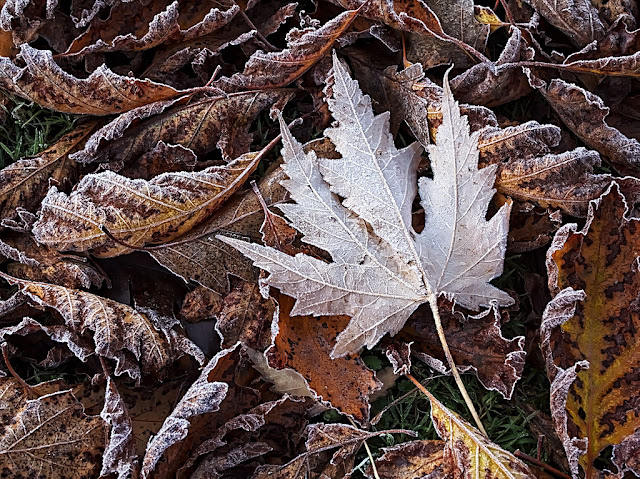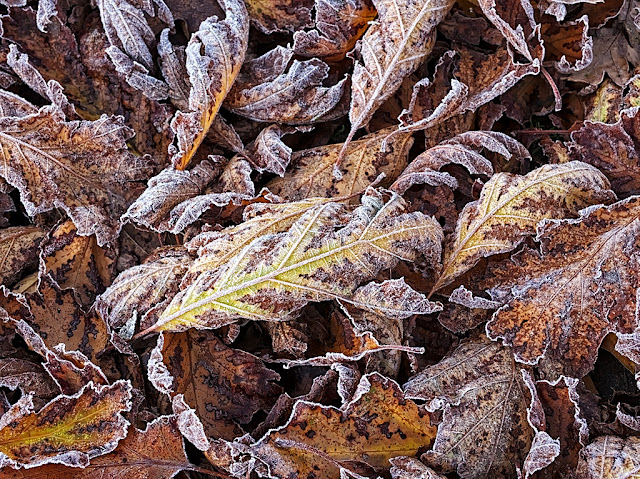 |
| Poplar Leaves - 2 November 2016 When on the tree, the yellow and red leaves would have been admired; on the ground, the range of colours is actually increased. |
We all admire the brilliantly coloured leaves of autumn while they are still on the tree. But when they fall off the tree, onto the ground, our attitude changes; their beauty is forgotten and we see them only as a nuisance. They make our streets and gardens untidy; they block the drains; and, they form a slippery layer on the railway lines, stopping the trains running to time. All that is left is to collect them up, and either burn them or put them in the rubbish; except for gardeners, who use the dead leaves for compost.
 |
| Contrasting Leaves - 8 November 2016 The maple leaf contrasts strongly with the surrounding oak leaves in colour, shape and texture. |
But there is still plenty of visual interest in the leaves as they rot away on the ground. While the vibrant colours remain for a few days at least after the leaves have fallen, the range of colours is increased, not only by browns, dark purples, and blacks of the decomposing leaves, but also by different coloured leaves from adjacent trees. Similarly, there are strong contrasts in shape and texture when a leaf from one tree falls on the leaves from a different type of tree.
Why Leaves Turn Red and Yellow
 |
Most of the colour of dead leaves derives from the breakdown of chlorophyll unmasking yellow and orange pigments already present. |
The process by which a living green leaf, producing sugar and oxygen from sunlight and air, turns bright red or yellow, and eventually falls to earth and rots away, starts when the length of the night exceeds a certain value. The tree then builds a barrier between the leaf and the rest of the tree, cutting the leaf off from nutrients absorbed through the roots, and tree from the sugar created in the leaf. As a result the green chlorophyll pigment decays, and exposes the yellow and orange colours of the xanthophylls and carotenoids normally present in the leaf.
 |
| Maple Leaves - 8 November 2016 Red pigmentation develops after the leaf is already dying. What is the advantage to the tree? |
Interestingly,
the red colours come from a third group of pigments, the
anthocyanins, which are only synthesised when the leaf is dying. It
is not entirely clear what the advantage to the tree is to have red
leaves in autumn. Theories include: to warn off aphids which might
want to use the tree as an overwinter host; to undermine the
camouflage of herbivores; or, to attract birds to the tree to eat
berries which may otherwise be overlooked. The anthocyanins in maple
leaves have been shown to stunt the growth of any nearby saplings.
The Weather For It
The
best display of autumn colour is produced when a moist growing season
is followed by a dry autumn with sunny days and cool, but not frosty
nights. Heavy rain, gales and frost are all likely to bring a
premature end to the display.
Folklore, Legend and Medicine
 |
| Oak Leaves - 8 November 2016 With a mass of leaves like this, it is easy to see why the Lakota believed they had been dropped as a protective blanket. |
Fallen
leaves, though such a prominent feature of the countryside in their
season, do not feature greatly in folklore. They have been
associated with fairies, with a swirl of leaves believed to be
evidence of fairies dancing. Catching a falling leaf, particularly
at the beginning of autumn, is said to protect the catcher from
illness, or, more specifically, colds, throughout the winter.
But,
perhaps, the most charming legend is that of the Lakota American
Indians. The god who looks after living creatures saw the suffering
of the plants and flowers as they shivered in the increasing cold of
Autumn. Feeling sorry for them, the deity ordained that the trees
should shed their leaves over the earth as a blanket to keep the
plants warm. In return, the trees were allowed one great last blaze
of glory.
I could find no reference to any medicinal use of fallen leaves. However, a Finnish company is developing the technology to extract natural pigments from the leaves for use in the clothing and cosmetic industries. The residual biomass is high in nutrients with possible uses as a fertiliser.
Next: More Autumn
I could find no reference to any medicinal use of fallen leaves. However, a Finnish company is developing the technology to extract natural pigments from the leaves for use in the clothing and cosmetic industries. The residual biomass is high in nutrients with possible uses as a fertiliser.
Next: More Autumn
No comments:
Post a Comment